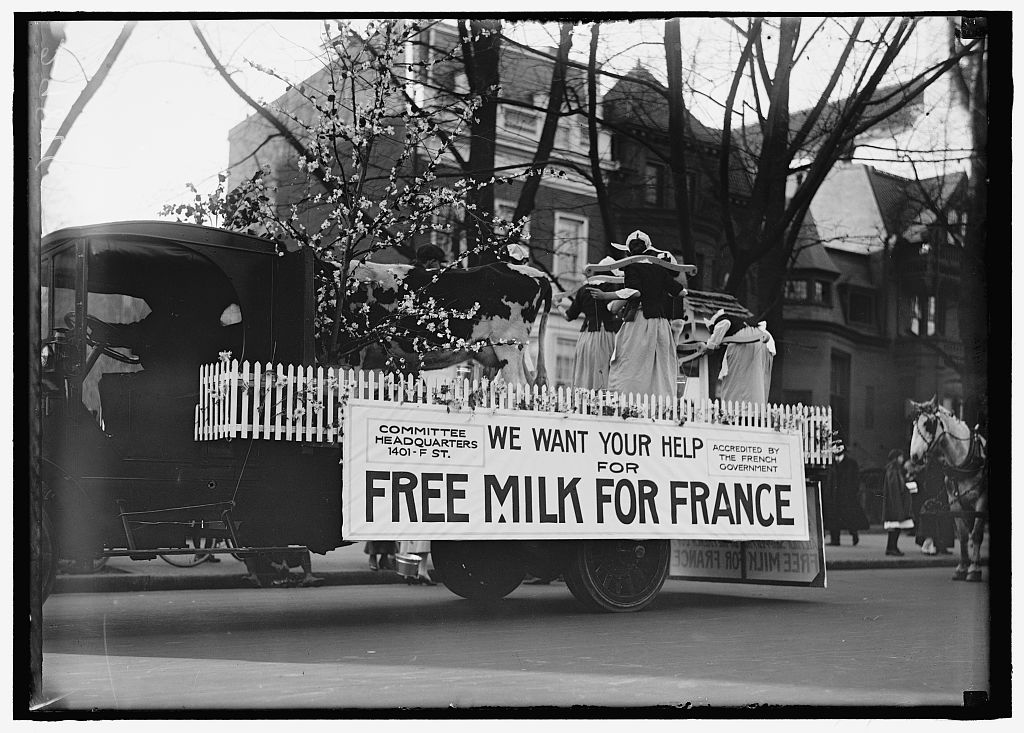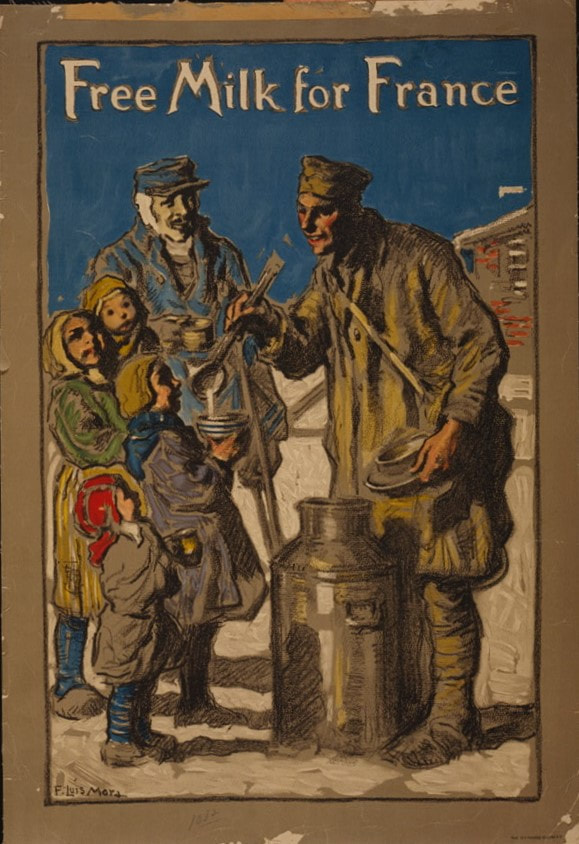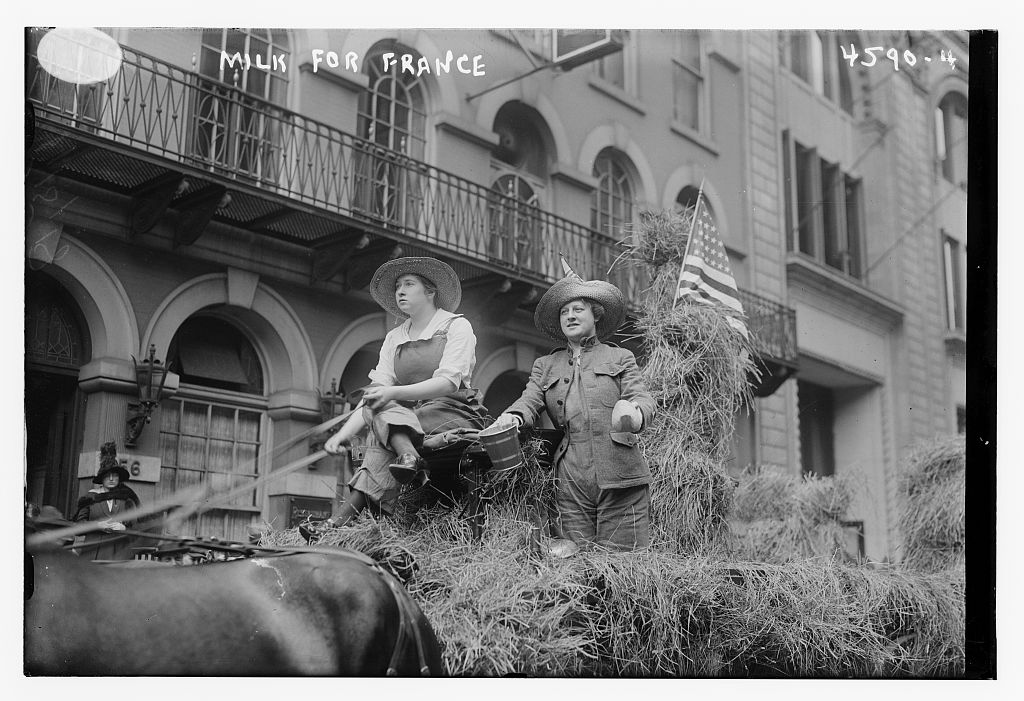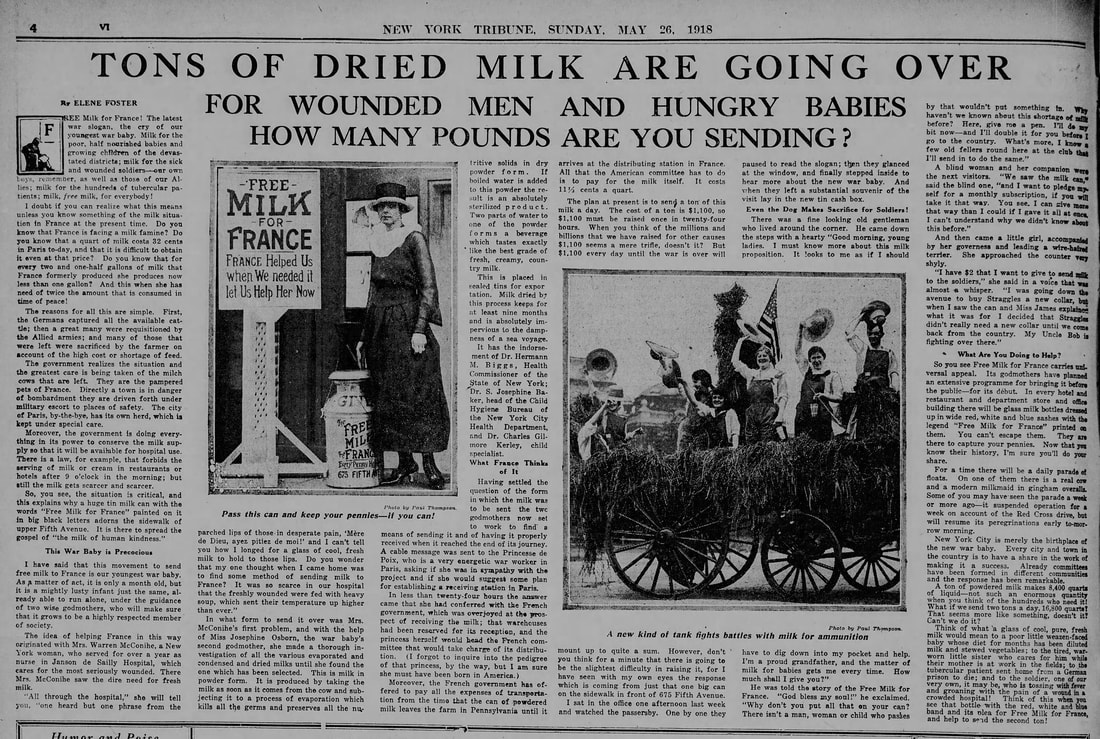|
Last week we learned about the big Dairy Exposition during WWI - this week we're examining the Free Milk for France movement, which coalesced about the same time. This propaganda poster by F. Louis Mora from 1918 is one of the more famous of the food-themed propaganda posters of the First World War. In it, a soldier ladles milk out of a large milk can into the bowl of a French child, one of several, accompanied by a wounded French soldier with a tin cup and crutch. Judging by how bundled up everyone is, it's probably winter. Ironically, the Free Milk for France campaign actually focused on provided dried milk. On May 13, 1918, the Committee to Obtain Free Milk for France launched a fundraising parade. "The parade, consisting of two floats and an escort of soldiers and sailors, including a navy band, started from the First Field Hospital Armory at Sixty-sixth Street and Broadway and canvassed the city as far down as the Wall Street District," reported the New York Times the following day. "The money will be used to purchase powdered milk to be sent to France for the use of wounded soldiers, babies, and tubercular patients." In the above photo, a woman dressed in overalls and a straw hat drives a team of horses pulling a large hay wagon. Another woman riding on the wagon is dressed in a military-style outfit holding a small bucket and a wooden shoe - likely soliciting donations. An American flag attached to a sheaf of hay is behind them. The first parade made over $1,000. The group launched another parade a few days later, on May 17th, parading "down Fifth Avenue from Fifty-ninth Street to Twenty-second Street yesterday afternoon." Featuring seven floats, including young society girls "dressed as milkmaids."  Free Milk for France parade, motor truck with a float of milkmaids with a live cow and flowering tree, surrounded by a white picket fence. A large sign reads, "We want your help for Free Milk for France," with smaller notes - "Committee Headquarters 1401-F St." and "Accredited by the French government." Harris & Ewing photographers, May, 1918. Library of Congress. In the above black and white photo, a flat bed truck features a large float carrying a flowering tree, a live dairy cow, and at least five young women dressed as Brittany milkmaids. The edges of the float are surrounded by a white picket fence. On May 19, 1918, the New York Times published "America Sending Milk to France." The article is transcribed below: One of the greatest sources of suffering in France has been lack of milk. The causes for this lack are manifold. In many instances the Germans slaughtered cows for beef whose greater value lay in their milk; in other instances the Government of France requisitioned the animals for army use, and in still others the farmers found themselves forced to kill their cattle on account of the shortage of pasture and fodder. All in all there have been lose to the people of France about 2,000,000 cows, and the main source of maintenance of infants and children, of the crippled and the wounded, the sick and tubercular, lies in milk. At present the death rate of children in France is from 58 to 98 per cent. The number of wounded and crippled needs no repetition here. The increase in the ranks of the tubercular is appalling. Outside Belgium, perhaps, there is no other country which has so greatly succumbed to this disease. The supply of milk in France has been depleted at least 16 per cent. Under present conditions infants must take vegetable stews as a food substitute. What this means to their health and their growth the mortality figures show. Wounded soldiers get heavy soups, which are well-nigh fatal in their effects. The tubercular of France have almost been forgotten. Milk has become a luxury far beyond the reach of the majority of them. In order to do something to meet this situation and to conserve the milk they have, the French Government is taking vigorous measures. Great care is devoted to the protection of milch cows. From bombarded towns, under military escort, two or three at a time are led back to places of safety. Farmers are urged to make all sacrifices possible to provide proper feed for them. Within Paris a herd of cows is kept under civic care. Government restriction now forbids the serving of milk or cream for any purpose in restaurants, hotels, or public eating places after 9 o'clock in the morning. In private homes, rich or poor, milk is only given to young children and the sick. Milk in Paris costs 32 cents a quart, when it can be bought. It was in a desire to do something to change these conditions that Mrs. Warren McConihe and Miss Josephine Osborne organized the Free Milk for France Fund. Mrs. McConihe had seen the soldiers suffering greatly for want of milk, she had seen them grow feverish under the influence of heavier foods. She had seen the Belgian and French refugees almost starved for lack of milk. Upon her return to this country she found that America had enough milk to send some across. Because it requires less shipping space, she chose powdered milk. It is scientifically prepared by subjecting fresh, pure, full-creamed milk to a rapid evaporating process, which preserves the nutritive solids and keeps without ice for months. The milk when prepared costs about 13 cents a quart. There is no other cost. The Government of France has taken over the details of transportation. It is the aim of the organization to send one ton of milk a day. All that is necessary is to mix with hot water. The milk in this form has been recommended even for home use by Dr. Hermann M. Biggs, State Health Commissioner; Dr. S. Josephine Baker of the Child Hygiene Bureau, and Dr. Charles G. Kerley, a child specialist. At a cost of $1,100 a ton of dried milk is sent across, enough to feed 8,400 babies or wounded soldiers or tubercular patients. $52 will send 100 pounds of dry milk or 40 quarts of liquid; $5.20 will sent ten pounds, or forty quarts, and 13 cents will send one quart. The aim of the Free Milk for France organization is to have the nation as a whole respond to its work. Branches are being organized all over the country. The headquarters of the fund is at 675 Fifth Avenue. These two parades, held during the National Milk and Dairy Farm Exposition, were just the first of a campaign that would last into 1919 and spread across the country. By the end of 1919, there were campaigns in thirty-six states, and the distribution in France was being organized by Madame Foch - wife of French General Ferdinand Foch. The rhetoric around milk and its importance in the diet, especially for children and the sick, would be replicated in the Second World War. The Food Historian blog is supported by patrons on Patreon! Patrons help keep blog posts like this one free and available to the public. Join us for awesome members-only content like free digitized cookbooks from my personal collection, e-newsletter, and even snail mail from time to time! Don't like Patreon? Join with an annual membership below, or just leave a tip! Join on Patreon or with an annual membership by June 30, 2020 and get a picnic history packet mailed to your door!
3 Comments
|
AuthorSarah Wassberg Johnson has an MA in Public History from the University at Albany and studies early 20th century food history. Archives
July 2024
Categories
All
|




 RSS Feed
RSS Feed